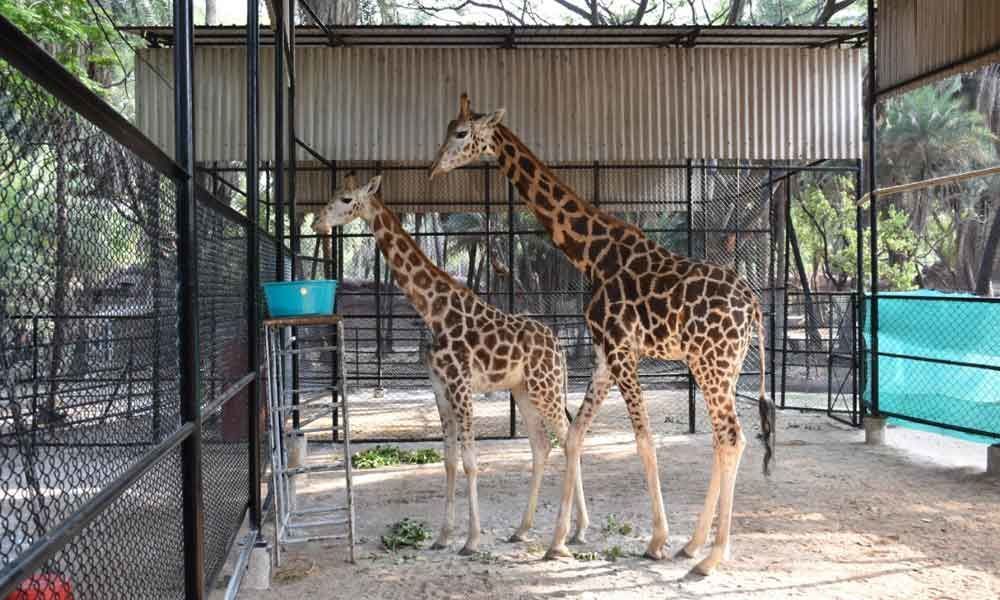Graceful giants to be top attractions at zoo
 Graceful giants to be top attractions at zoo
Graceful giants to be top attractions at zooThe young pair of giraffes Sunny and Bubli will be joining Tsunami Basant (the only one of their kind) in the Zoo, to become one of the top attractions of the Zoo this summer.
Bahadurpura: The young pair of giraffes Sunny and Bubli will be joining Tsunami Basant (the only one of their kind) in the Zoo, to become one of the top attractions of the Zoo this summer.
While Sunny (male, 3 years and 9 months old) and Bubli (female, 2 years old) were recently relocated from Kolkata's Alipore Zoo, the existing Giraffe Tsunami Basant remains the only largest mammal besides elephants in Nehru Zoological Park for about last 10 years.
According to officials, the pair of these gigantic species of mammal is getting ready to attract the visitors, particularly the young visitors, during their summer vacations in Nehru zoological park.
These Giraffes were kept under quarantine period after they were brought from West Bengal. By the end of April, their quarantine period will be completed. The zoo authorities are gearing up to release them in an enclosure especially developed to keep these exotic animals under public display.
Giraffes amongst most fascinating mammals
Most giraffes weigh from 600 to 2000 kg. In addition, these exotic animals also have long tongues, which can be extended more than 45 centi metres ! It helps them grasp twigs and leaves more easily. Their horn tips, which are located on the top of their head, are about 4-5 centimetres high. Their heart weight can reach up 10 kgs. Each bone in a giraffe can be about 10 inches (25cm).
If you look closely, you can see that these unique mammals have a ridiculously long tail of about 78-100 centimetres (31-39 inches). Their neck, the body part that boosts up their size even more can reach up to 7 feet tall (2.1 meters).
These tall animals are identified by their long necks, equally long and spindly legs, and spotted coats. Most giraffes have a tan, white or yellow coats that are spotted with brown, square shapes. A giraffe's neck alone is 6-foot (1.8 meters) long and weighs about 272 kilograms. The animal's legs are also 6-foot-long.
Remain social, don't have territories
According to the US Geological Survey, giraffes are so social that they don't have territories. A group of giraffes is called a tower. Towers typically have 10 to 20 members. Some towers consist of all females and their young, or all male or mixed genders. According to PBS Nature, in wild, these giraffes only sleep around 20 minutes or less per day. Staying awake most of the time allows them to be constantly on alert for predators. They usually get their sleep in quick power naps that last just a couple of minutes.
Every giraffe has two hair-covered horns called ossicones. Male giraffes use their horns to playfully fight with one another. They also spar by swinging their heads at one another and entwining their necks, which is called 'necking'.
Long necks help reach branches for leaves
Giraffes are herbivores, which mean they eat only plants. Their long necks allow them to reach leaves, seeds, fruits, buds and branches high up in mimosa and acacia trees. They can eat hundreds of pounds of leaves per week, according to National Geographic.
Though these animals eat a lot, giraffes can go without drinking for weeks at a time. They get most of their moisture from the vegetation they eat.
As in cattle, female giraffes are called cows, while the males are called bulls. After mating, the cow will have a gestation period of around 14 months. Baby giraffes are called calves. During birth, the calf will drop to the ground, since mother giraffes give birth standing up. The fall can be as far as 5 feet (1.5 m), according to National Geographic.
New calves are quite large, at 6 feet tall (1.8 m), they are around 45 to 68 kg. They are also agile and at just an hour after birth, they can stand up and walk around. The animals can live 10 to 15 years in the wild and 20 to 25 years in captivity.

















